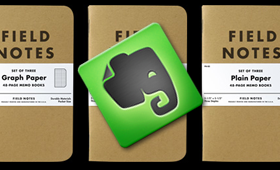If you are creative, you’ve encountered this problem. You never know when an idea will hit you, and when it does, you know that if you don’t capture it soon, it may be lost forever.
Scatter Shot
So you might grab a napkin, or a post-it note, or whatever and jot down the idea. Whew! Got it. Now what? Over time, the ideas keep coming, and so do the little scraps of paper. Eventually it’s time to sit down and really create the thing, and where are all your little nuggets of gold? Hmmm…they must be around here somewhere…let’s see.
Speed Bump
As a client recently told me, “I think I’m ready to start crafting this new business idea, but my ideas are so scattered that it’s going to take me a while just to find everything and start to focus.” Not the most efficient way to get started. In fact, the effort of collecting everything might prevent you from taking a few small steps in the right direction. There must be a better way.
Ubiquitous Capture
What you need is a way to capture any idea wherever you are. Ideas will come to you when you are driving, walking, eating, in the shower, during a boring meeting, even in bed. Do you have a good way to capture the idea? If not, revise your system now.
Paper or Plastic?
I’ve found two ubiquitous capture solutions that work for me. One is the paper approach. Here I carry around a notebook that is small enough to take anywhere. I like Field Notes but any small notebook can work.
Paper Benefits:
- Tangible, organic, and direct
- Slows me down so I can preprocess ideas as they come out (but no editing, please)
- No batteries, cables, or interface barriers
- Quick (no friction—waiting to power on, launch, or sync)
For a standout example of the paper approach in practice, see Twyla Tharp’s box approach found in The Creative Habit
See also puzzlemaster Will Shortz describing how he uses index cards to capture ideas for making puzzles (from the documentary Word Play).
Going Digital
Recently I’ve switched to using apps for ubiquitous capture. I usually have my phone with me anyway, and having the same tool on my iPad and Mac means I can dig in deep with a big screen when I want to develop the idea further.
Digital Benefits:
- Easy to repurpose in create mode (you are halfway there)
- Captures photo and voice when out and about (typing isn’t the only input method)
- Easy to reference other digital assets like files and websites (most ideas are related to other ideas)
- Content can be shared with coworkers and clients (most ideas involve others)
- Automatically backs up to the cloud (I never lose anything)
- Searchable (I can be messy and still find it later)
Evernote
The best tool I’ve found so far for this is Evernote. I like it for all the advantages above, and because it’s particularly well designed for sloppiness (who can bother to organize ideas when they are flowing fast?), it’s good at syncing (always available from any device), and it comes from a thriving development community.
Experiment with different tools and pick the one that has the least friction, that has you dumping your ideas the quickest.
The Test

For best results, pick paper or plastic, but don’t mix them.
The test of your system is simple.
- Capture: If you have a brainstorm right now, can you record it?
- Access : Once you record it, can you get it when you need it?
- Create : Once you have it, are you well positioned to do something with it?
If the answer is “yes” to all three, then you have a great ubiquitous capture system.
Capture or Sweep?
Note that Ubiquitous Capture is not the same as Mind Sweep. Mind Sweep is about gathering up all the little tasks you’ve been keeping track of and getting them out so you can process them. It clears your head so you can work. Ubiquitous Capture is more about recording the fresh ideas and insights as they come to you.
Advanced Course
You might pick different capture methods for different projects. I find that some projects lend themselves more to the paper approach. For other projects, digital is the way to go. But if I’m using two systems, I have to carry both of them with me all the time, or it doesn’t work. Mixing paper and digital in the same project can lead to frustration.